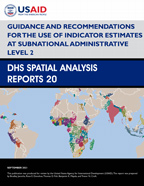- PUBLICATIONS
- JOURNAL ARTICLES
- ACCESS PUBLICATIONS
Publications Summary
- Document Type
- Spatial Analysis Reports
- Publication Topic(s)
- Geographic Information
- Language
- English
- Recommended Citation
- Janocha, Bradley, Rose E. Donohue, Thomas D. Fish, Benjamin K. Mayala, and Trevor N. Croft. 2021. Guidance and Recommendations for the Use of Indicator Estimates at Subnational Administrative Level 2. DHS Spatial Analysis Reports No. 20. Rockville, Maryland, USA: ICF.
- Download Citation
- RIS format / Text format / Endnote format
- Publication Date
- September 2021
- Publication ID
- SAR20
Download
 Guidance and Recommendations for the Use of Indicator Estimates at Subnational Administrative Level 2 (PDF, 3162K)
Guidance and Recommendations for the Use of Indicator Estimates at Subnational Administrative Level 2 (PDF, 3162K)
Download this publication
There is no printed copy available to order.
